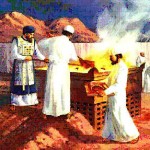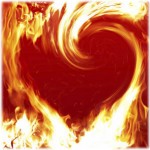Musings from Students of the Pardes Institute of Jewish Studies in Jerusalem
Posted on March 21, 2013 by Joseph Shamash
In last week’s Parsha, the first 5 Chapters of the book of Vayikra described the variety of sacrificial practices that were addressed to the Children of Israel (Burnt, Flour, Peace, Sin and Guilt Offerings). This week, in parshat Tzav we continue with more details and regulations that are directed to the priests, namely Aaron and his sons but in a slightly different order (Burnt, Flour, Sin, Guilt, Peace). Peace falls two spots from 3rd to last place!
 For our purposes, we’re gonna focus on the first sacrifice, the Olah (burnt-offering):
For our purposes, we’re gonna focus on the first sacrifice, the Olah (burnt-offering):
“And God spoke to Moshe saying, Command Aaron and his sons saying: This is the law of the olah; it is the olah which shall burn upon the altar all night until the morning, and the fire of the altar shall burn in it. And the kohen shall wear his linen garment, and he shall wear linen trousers upon his flesh, and he shall take up the ashes which the fire has consumed with the olah upon the altar, and he shall place them beside the altar. And he shall remove his garments and wear other garments, and he shall remove the ashes outside of the camp, to a place that is pure. And the fire upon the altar shall burn in it, it shall not be extinguished, and the kohen shall burn wood upon it every morning, and he shall set the olah upon it and burn the fat of the shelamim upon it. An eternal fire shall burn upon the altar; it shall not be extinguished.” (Vayikra 6:1-6)
For me, what’s stands out here is the process the priest has to go through to dispose of the ashes in 3 distinct locations with descending levels of purity:
First, the offering is completely consumed by fire on top of the altar
(Super, super holy spot, you can’t get much holier than that!)
Then the ashes are shoveled and piled up to the side of the altar
(Okay, still pretty holy right next to the altar).
Finally, the priest changes out of his priestly garments, puts on other clothes* and takes the ashes outside the encampment to a “place that is pure.”
(Well, at least it wasn’t outside the camp in a ritually impure place).
(*I like to think that he changed into jeans and a tuxedo t-shirt and the other priests wouldn’t let him leave unless he had ample water and a hat to shield him from the heat of the wilderness.)
So what’s this whole process trying to teach us?
According to Rav Kook, “the ultimate objective of the Temple service is bringing the Divine Presence into our physical world (hashra’at Shechinah)…the Olah offering, completely burnt on the altar, corresponds to the highest level of communication between us and God, a sublime level in which the material world is of no consequence.”
 Okay, so we are trying to transcend physicality and bring God’s eternal message into our lives. I like it, more cowbell, I mean Rav Kook please…
Okay, so we are trying to transcend physicality and bring God’s eternal message into our lives. I like it, more cowbell, I mean Rav Kook please…
“The prophetic experience is a blaze of sacred flames inside the human soul, a divine interaction that transcends ordinary life. This extraordinary event corresponds to the first stage, the nighttime burning of the offering in the fire of the holy altar.
However, the prophet wants to extend the impact of this lofty experience so that it can make its mark on his character traits and inner life. This effort corresponds to the placement of some of the ashes, transformed by the altar’s flames, next to the altar. This is a secondary level of holiness, analogous to those aspects of life that are close to the holy itself, where impressions of the sacred vision may be stored in a pure state.
The lowest expression of the prophetic vision is in its public revelation. Informing the people of the content of God’s message, and thereby infusing life and human morality with divine light — this takes place at a more peripheral level. Outside the inner camp, bordering on the domain of secular life, the kohen publicly brings out the remaining ashes.”
So lemme get this straight…the burning of the sacrifice represents a prophetic experience that transcends one’s soul and in order to sustain that “high”, we leave the ashes nearby as a reminder and to allow it to penetrate our DNA and affect our character. Once, we’re changed from the inside we, we put on another set of clothes that we don’t mind if they get dirty and we bring our more elevated selves out to transform the rest of the world…Way to go Rav Kook!
But the problem remains, we don’t have the Mishkan, we don’t have the Temple and we don’t do sacrifices, so how do we make this relevant to our lives now?
Well, our sages were pretty clear about this – Prayer or what I like to think is a better term for it, “Avodah SheBalev” (Worship of the Heart).
Back to the instructions for the priest:
“And the fire upon the altar shall burn in it, it shall not be extinguished, and the kohen shall burn wood upon it every morning, and he shall set the olah upon it and burn the fat of the shelamim upon it. An eternal fire shall burn upon the altar; it shall not be extinguished.”
For the fire to continue burning, we have an opportunity everyday in our lives to reignite that spark and establish a connection with the Divine that resonates within us and ultimately impacts the world at large. The challenge (and boy can it be challenging) is to make prayer personal and transformational so we actually want to do it 3 times a day and hopefully with some sincere intention!
As we look ahead to Passover next week and begin our search for “chametz” (leaven) in our homes and lives, I’m reminded of the various “Chametz Burning Stations” that seemingly pop up all over Jerusalem. People from all over the city bring piles of chametz that have collected over the year and burn it all in a symbolic fire that represents a purification of our excess, our pains, fears and shortcomings that have transpired throughout the year. And we stand there and watch them disappear into the fire and turn into smoke and ashes. We collectively remove some of the baggage and the weights that prevent us from reaching our fullest selves as we hope for a brighter and more successful future.
After the chametz has been burnt in the fire, we recite the following declaration:
“All leaven or anything leavened which is in my possession, whether I have seen it or not, whether I have observed it or not, whether I have removed it or not, shall be considered nullified and ownerless as the dust of the earth.”
May we all carry a light load and have the discipline and desire to keep the sparks of our souls ignited with Divine light.
Shabbat Shalom and Chag Sameach!
PS. After failing to do this last year, a word of advice for those living in J’lem – make sure to keep your windows closed on Monday!